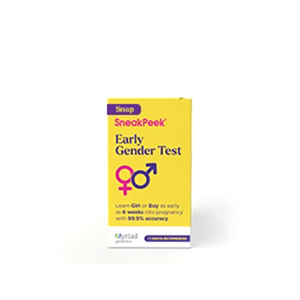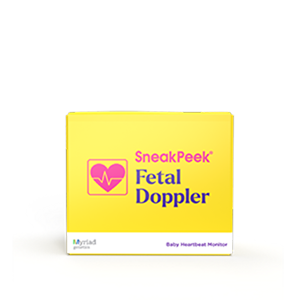Published on March 28th, 2022 and Updated on January 16th, 2024
Check out SneakPeek Gender Test to find out your baby’s gender as early as 6 weeks at over 99% accuracy1!
In the world of adult nutrition, probiotics are all the rage. After all, who doesn’t love a little digestive support? If you’re a probiotic proponent and a new parent, you may be wondering if your little bundle of joy could also use a gut health boost with your fave probiotic powerhouse—yogurt.
Should you be serving yogurt? And if so, when can babies eat yogurt?
Currently, there’s scant evidence to indicate babies benefit from probiotics, whether in their immune responses or the health of their microbiome. Where does that leave yogurt?
Although your baby may not benefit from yogurt’s probiotic content, you can still let him try yogurt as early as 6 months old—even before he tries cow’s milk at 1-year-old. In this article, we’ll break down why yogurt may suit your baby better than milk and how you can introduce him to this delectable staple safely.
When To Introduce Your Baby To Yogurt
Breastmilk remains the unparalleled liquid gold of infant nutrition. What’s in breastmilk? Chock full of good bacteria, enzymes, fats, and minerals, breastfeeding your little one can help set her up with a resilient immune system, digestive tract, and brain.
The American Academy of Pediatrics (AAP) recommends introducing complementary foods (liquid or solid foods outside of breastmilk and formula) to your child around 6 months old to diversify diet and supplement nutrition. Some common types of complementary infant foods are:
- Fortified cereal
- Pureéd baby foods
- Soft or mashed fruits and vegetables (for instance, banana or sweet potato)
As you add complementary foods to your little one’s diet, the AAP advises the following:
- Introduce your baby to new foods one ingredient at a time, with 3 days between each, to make sure there’s no adverse reaction.
- Choose foods that promote natural nutrition—which means staying far away from processed snacks and added sugars.
The AAP also advises that parents wait to give their baby cow’s milk until they’re at least 1-year-old. So, if milk is off the table (or should we say, out of the bottle) until 12 months, when can babies have yogurt?
Fortunately, yogurt may be incorporated into your baby’s diet when she’s 6 months or older, unless your pediatrician specifies otherwise.
Why can’t babies have cow’s milk before 1 year?
Scientists agree that infants under the age of 1 should not be given cow’s milk to drink because it impedes your baby’s well-being in 2 ways:
- It’s iron-deficient – Cow’s milk doesn’t contain the amount of iron babies need in this tender stage of growth. In addition, the high quotient of calcium and casein in cow’s milk actually prohibits the absorption of some iron from breastmilk and formula.
- It can cause severe dehydration – Because cow’s milk has more protein and minerals than your baby requires, the remainder is to be processed through the kidneys and exit the body as excess urine. The more babies pee, the more challenging it is for their bodies to maintain water levels, and the more vulnerable they are to becoming dangerously dehydrated. If you’re concerned about your baby’s hydration or wondering, can babies have Pedialyte as an alternative to water? Explore our blog for guidance on suitable hydration options.
After your baby’s first birthday, you can give him milk to diversify his diet and support his growth. Offering pasteurized whole milk instead of skim or partially-skimmed milk is recommended, as skim and partially-skimmed options don’t have enough calories, healthy fats, or vitamins for growing little ones.
The Benefits of Yogurt for Babies
There are two reasons why yogurt is a good complimentary food to serve your baby:
- Yogurt is cultured – Yogurt is made with bacterial cultures that break down the sugars and proteins in milk. This means the proteins are much easier for your baby’s digestive system to process, while retaining all the nutritional benefits that come from milk, like vitamin D.
- Yogurt is easy to eat –Choking hazards are a common concern when introducing your little one to solids, especially if this is your first go-around with parenthood. The silky consistency of yogurt is easy for babies to swallow, making it a great complementary food choice.
Lastly, yogurt can be made from a versatile spectrum of base ingredients. While the jury is still out on if it’s advantageous to feed soy to infants, other varieties of plant-based yogurts are available if that’s your preference.
What To Consider When Feeding Yogurt To Your Baby
Before you break out your tiniest spoon to let your baby try your triple-strained Greek yogurt, some things to keep in mind:
- Aim for full-fat – While decades of pop science have branded fat as “bad,” fat remains an essential macronutrient that aids infant brain development and a host of other functions in the body. In fact, when it comes to how many calories does a baby need, the AAP suggests that half of infants’ daily calorie intake should come from fats. Stick to full-fat options like whole milk yogurt for your baby and veto the skim varieties (which tend to pile on added sugar to make up for the fat deficit). Skip the dairy-free yogurts, too, like coconut yogurt or yogurt made with almond milk, as these won’t provide much for your baby.
- Nix added sugars – You may love a fruit-at-the-bottom yogurt parfait for your morning breakfast, but sugary, flavored yogurt isn’t a good idea for babies. The fermentation process used to make plain yogurt means it already contains sugar, so be sure to check nutritional labels and exclude any products that use added or artificial sweeteners on your next grocery run.
Plain yogurt can be tart on its own, which isn’t typically a flavor that infants go nuts for (although it can be charming to see your little guy pull a sourpuss face). If you do want to add some sweetness, try mixing in some fruit pureé your baby already enjoys. It’s an excellent way to make yogurt sweeter without sacrificing nutrition. If you like making homemade baby food, making your own frozen yogurt pops are also a fun way to introduce yogurt to your young chlid, and you can customize them however you like. To save a bit on money, don’t worry about purchasing organic yogurt or dairy products, as the AAP says there is no evidence of relevant differences between organic and conventional.
What about Greek yogurt?
Greek yogurt is heralded for being a filling, lush, nutrient-dense snack for adults. Is Greek yogurt okay to feed babies?
Yes! Here’s everything to know when introducing it to your child:
- It’s naturally soothing – The creamy consistency of Greek yogurt can have a calming effect on infants and adults alike. What’s more, if your baby has started the process of teething, Greek yogurt’s cooling properties can make it an excellent, soothing snack for sore gums, distress, or general fussiness.
- It may be more digestible– Greek yogurt differs from regular yogurt because it undergoes a more thorough straining process. This gives it a thicker consistency and makes the yogurt more refined, reducing the amount of lactose in the final product and screening out potential allergens like whey. As such, Greek yogurt may be a good first milk-based product for your baby to try if you’re concerned about a milk allergy.
If you’re worried about letting your infant try thicker types of yogurt, you can try mixing it with water or breastmilk to thin its consistency. For all other concerns related to feeding Greek yogurt to your baby, your pediatrician is your best ally.
How To Know If Your Baby Is Allergic To Yogurt
Approximately 2.5% of kids under 3 years old have a milk allergy. As yogurt’s main ingredient, it’s important you know what allergic reaction symptoms to look for when serving your little foodie yogurt for the first time.
Here are some signs your baby may have a milk allergy:
- Rapid-onset hives
- Congestion or runny nose
- Indigestion
- Vomiting
- Coughing or wheezing
- Diarrhea or loose stool
Milk allergy symptoms may arise immediately or over a few days, which is why it’s so important to let your baby try new foods one at a time, with a 3-day grace period between new ingredients. On the whole, severe milk allergies that can prompt anaphylaxis are rare, but if your baby experiences any trouble breathing, call your doctor immediately.
What about lactose intolerance?
Lactose intolerance is a condition where a person lacks the digestive enzyme required to adequately process lactose. Lactose intolerance is not a dairy allergy, but it is a common condition affecting around 75% of people worldwide.
However, lactose intolerance typically develops later in life. This means that baby dairy intolerance, is extremely rare. In fact, the vast majority of babies’ digestive systems are born ready to process lactose, as it’s one of the primary compounds found in breastmilk and the chief carbohydrate in their diet while they’re breastfeeding.
In conclusion, yogurt can be a beneficial addition to your baby’s diet starting around the age of six months, thanks to its easily digestible nature and rich nutritional value. However, it’s crucial to introduce it properly and monitor your child for potential allergies or adverse reactions, and always consult with your pediatrician for any specific concerns or dietary guidance.
Sources:
- National Institute of Health. Probiotic supplementation and associated infant gut microbiome and health: a cautionary retrospective clinical comparison. https://www.ncbi.nlm.nih.gov/pmc/articles/PMC5974413/
- National Library of Medicine. Adverse effects of cow’s milk in infants.https://pubmed.ncbi.nlm.nih.gov/17664905/
- Grow by WebMD. What to Know About Cow’s Milk for Babies. https://www.webmd.com/parenting/baby/cows-milk-for-babies#091e9c5e821aa1b4-2-6
- National Institute of Health. Review of Infant Feeding: Key Features of Breast Milk and Infant Formula. https://www.ncbi.nlm.nih.gov/pmc/articles/PMC4882692/
- Centers for Disease Control and Prevention. Timing of Introduction of Complementary Foods –United States, 2016–2018. https://www.cdc.gov/mmwr/volumes/69/wr/mm6947a4.htm
- National Institute of Health. Nutrient intake, introduction of baby cereals and other complementary foods in the diets of infants and toddlers from birth to 23 months of age. https://www.ncbi.nlm.nih.gov/pmc/articles/PMC7109529/
- San Francisco Gate. Fatty Foods for Infants. https://healthyeating.sfgate.com/fatty-foods-infants-7165.html
- National Institute of Health. Lactose intolerance: diagnosis, genetic, and clinical factors. https://www.ncbi.nlm.nih.gov/pmc/articles/PMC3401057/
- Food Allergy.org. Milk Allergy. https://www.foodallergy.org/living-food-allergies/food-allergy-essentials/common-allergens/milk
- Healthline. Can Babies Have Yogurt? https://www.healthline.com/health/parenting/can-babies-have-yogurt

Shop Our Products
SneakPeek aims to provide the most accurate and up-to-date information to help our readers make informed decisions regarding their health before, during, and after pregnancy. This article was written based upon trusted scientific research studies and/or articles. Credible information sources for this article are cited and hyperlinked.





